It pays to grow Project 50
June 7, 2012
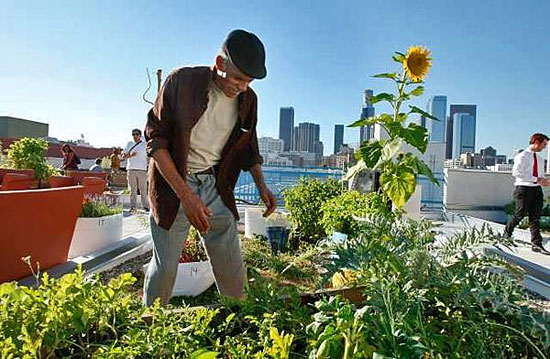
Jacques Walker, an original Project 50 client, in the rooftop garden of Skid Row Housing Trust’s Cobb Apartments.
When we first launched Project 50, targeting the most vulnerable homeless residents on Skid Row for housing, medical care, mental health and other critically important services, we knew it was the right thing to do.
What we didn’t know for sure was whether this pilot project would pencil out in Los Angeles—as it has elsewhere—as a financially smart way to cut the incredibly high costs associated with chronic, long-term homelessness.
Now we know.
A new report assessing the cost-effectiveness of Project 50 is in, and the results offer powerful support for the economic benefits of doing the right thing by some of the people our society has shamefully left by the wayside for far too long.
The study, by the county’s Chief Executive Office, found that Project 50 in its first two years actually saved more money than it spent—with $3.045 million invested in the program resulting in savings of $3.284 million. Put another way, each permanent supportive housing unit we provided over those two years saved the taxpayers $4,774.
Even for Project 50’s most committed supporters like me, those are some mighty impressive numbers.
Yes, we spent more money on mental health care and substance abuse treatment for Project 50 participants—but we saved even larger amounts than we would have spent incarcerating them or caring for them in our clinics and emergency rooms if their conditions had gone untreated.
What’s even more intriguing is how Project 50 participants’ mental health care costs stacked up compared to those of a similar group of homeless people not in the program. Both groups had rising mental health care costs after Project 50 started—but the Project 50 group’s care cost significantly less. That’s because they received mental health outpatient care, unlike members of the comparison group, who needed far costlier hospital and emergency room crisis treatment.
Since our goal in launching this project in 2008 was to move the most hard-core homeless people off the streets, while supporting them with services to combat their substance abuse and mental health demons, these data provide vindication for the “housing-first” approach.
If we can meet people where they are—not where we wish they were, in terms of drug and alcohol abuse—we can make a profound difference, not just in their lives but in the county’s bottom line.
Since Project 50 began, we and our coalition of partner agencies have expanded the concept beyond Skid Row to reach chronically homeless people in Hollywood, Santa Monica, Venice and Van Nuys. We’ve also launched Project 60, which serves chronically homeless veterans.
In all, nearly 600 lives have been touched by this remarkable program.
This new assessment of Project 50’s cost-effectiveness shows that it’s time to think even bigger. I believe we can set our sights on reaching all of the approximately 11,000 chronically homeless individuals who sleep on our county’s streets each night.
Taking a “housing first” approach with each of them is the right thing to do—and it turns out to be a great investment, too.
Read the Los Angeles Times’ report on the new study here.
Posted 6/6/12
Paddling out to revive an old sport
June 6, 2012
Before short boards, Gidget and the 1960’s surfing explosion, paddleboards were shredding the waves at the Santa Monica Pier.
Over the past ten years, paddleboard racing has seen a major revival. That revival continues Saturday at the Santa Monica Pier Paddleboard Race & Ocean Festival, a benefit for marine conservation group Heal the Bay.
“The race takes place in such a historic location—it ties together the modern rebirth of the sport with its roots,” said event spokesman Andrew Rice.
Paddleboard racing was invented in Santa Monica in the late 1920s by swimming champion Tom Blake. Blake designed a lighter version of the existing plank surfboard, enabling riders to maneuver more easily in the water. People typically laid or kneeled on the boards and used their hands and feet for propulsion. By the 1930s, organized races were held regularly in the Santa Monica Bay. After the sport’s popularity peaked in the 1940s, it was replaced by a new generation of surfing.
“What killed it as a sport was when modern surfboard design came around,” Rice said. “With Gidget and the surfing culture of the ‘50s and ‘60s, that just blew it out of the water.”
After decades of obscurity, paddleboard racing is back in a stand-up version where contestants propel their boards with long paddles, said Rice.
The Santa Monica Pier Paddleboard Race isn’t the largest of its kind, but it’s steeped in history. To underscore that history, the festival transforms half of the pier’s parking lot into a temporary surf history museum with antique boards, artifacts, historic photos and classic beach cars.
Surf legends like Kathy Kohner-Zuckerman (the real-life inspiration for “Gidget”) and Jeff Ho (of Dogtown fame) have been drawn to the event. This year, Esther Lorenz Maire, winner of the national paddleboard race in 1947, will be on hand to talk about the sport and its history.
The day’s paddleboard races come in 5.5-mile, 1.5-mile and relay versions. New this year, there will also be a “Run-Swim-Run” and a 1-mile ocean swim for non-paddleboarders. Registration, online or in person the day of the event, ranges in cost from $10 to $55. There will be plenty of other entertainment at the festival as well, including Hawaiian-style guitar playing, hula dance troupe performances and live tunes from ska/reggae band The FuDogs. Registration begins at 7:30 a.m., Saturday, June 9. See the website for a schedule of races and activities.
The event, now in its third year, has already experienced major growth. Both the number of races and the size of the pop-up surfing museum have doubled this year to accommodate the hundreds of racers and thousands of attendees expected.
“It is turning into something that will really be a great source of community and financial support for Heal the Bay’s educational center,” Rice said.
Posted 6/6/12
Wilshire ramps by the numbers
June 6, 2012
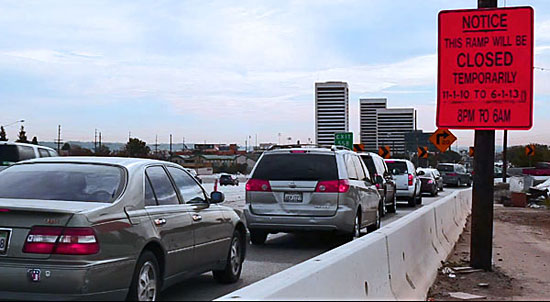
Thousands of accidents, millions of lost "person hours" sitting in traffic: that's life on the 405 and Wilshire.
It’s not just a local gripe magnet. The 405 Freeway has a national reputation—and it’s not a nice one. “Somewhere between notorious and terrible,” says Tim Lomax, a senior research engineer for the Texas Transportation Institute. When you throw in the upcoming closure of the 405 ramps at Wilshire Boulevard for a long-running construction initiative that starts June 22 as part of the 405 Project, you’ve got a long-simmering recipe for making motorists stew. Here are some of the ingredients that make this the intersection we love to hate:
- Vehicles traveling on Wilshire: An average of 105,721 vehicles a day cross the intersection of Wilshire and Sepulveda Boulevard, right next to the freeway
- UCLA-bound students and staff traveling through the area: 20,000 (summer), 25,000 (academic year)
- Busiest ramp in the morning: exit ramp from the northbound 405 to eastbound Wilshire, with 1,494 vehicles an hour at peak of morning commute time
- Busiest ramp in the afternoon: westbound Wilshire onramp to the southbound 405, with 1,301 vehicles an hour at peak of afternoon commute time
- Number of “Top 40” appearances in the Texas Transportation Institute’s 2011 Congested Corridors Report: 6, out of 7 possible categories. The 13.1 mile corridor of the 405 that runs from the 105 Freeway to Getty Center Drive—and includes the Wilshire intersection—ranks among the worst in the country for heavy congestion, truck traffic and jammed conditions during the morning, midday, afternoon and weekend periods.
- “Person hours” lost to traffic delays in the corridor: 12.6 million a year
- Fuel wasted: 6.057 million gallons annually
- Congestion cost in time and fuel: $269.9 million a year
- How bad travel times in the area will be after construction starts: Plan on everything taking twice as long, at least at first.
- Likelihood the person in the car next to you during those traffic delays will be eating: 39.13% of motorists admit to eating or drinking behind the wheel, a survey found.
- Likelihood the person in the car next to you will be talking on the phone: 30.1% say they chat while driving.
- Likelihood they’ll be texting or putting on makeup: Just 8.6% and 2.95%, respectively.
- Best public transportation option: Metro’s 761 bus, which runs from the Valley to Westwood
- Total number of ramps to be rebuilt: 8
- First two ramps up for closure: westbound Wilshire onramp to the northbound 405 and northbound 405 off-ramp to westbound Wilshire
- Cost of rebuilding those two ramps: $2.65 million
- Overall cost of the entire 405 Project: $1.034 billion
- How long it will take to finish the ramp work: approximately 1 year, including the time it will take to build new “flyover ramps” intended to make the intersection move better and more safely.
- Number of project nicknames so far: 2, Ramp Jam and The Rampture.
Sources: Los Angeles Department of Transportation, Los Angeles Police Department, California Highway Patrol, Caltrans, Metro, Texas Transportation Institute’s 2011 Congested Corridors Report; insurance.com, UCLA
Posted 5/16/12
Expo opens to Culver City on June 20
June 5, 2012
The Expo Line hits full strength on June 20, when the light rail’s Farmdale and Culver City stations open to the public.
The opening completes the 8.6-mile first phase of the line, which debuted with stations originally extending as far west as La Cienega on April 28. A second phase to extend the line all the way to Santa Monica is now being built.
The elevated Culver City station opens up a gateway to the city’s popular eateries and other attractions, including the quirky Museum of Jurassic Technology.
The Farmdale station, near Dorsey High School, was not originally part of the line, but was added later, after the Public Utilities Commission approved a station at the site. The Culver City station, original conceived as an interim station for phase one, changed course and became an elevated, permanent station after state funding became available.
Expo CEO Rick Thorpe said a 600-space park-and-ride lot will open along with the Culver City station, and bus lines in the area will be realigned to feed into it.
“It should be a very, very heavily used station,” he predicted.
The stations will open at noon on Wednesday, June 20. That means that participants can ride Expo to Culver City’s Third Wednesday “Summer Solstice” Happy Hour, with attractions including music from a six-string electric cello, an open house at the Kirk Douglas Theatre, dancing and all kinds of liquid refreshment at local watering holes.
Posted 6/5/12
Rollin’ on the river
June 5, 2012
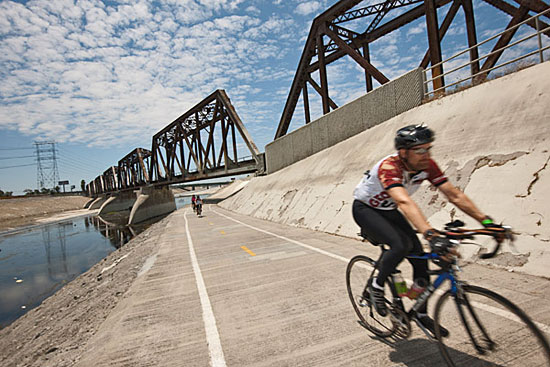
The L.A. River Ride bridges the past, present and future of the cycling revolution. Photo/Minami Pictures
Years before Los Angeles streets went car-free for the freewheeling festivities known as CicLAvia, bike advocates were already forging a path with the L.A. River Ride.
Now in its 12th year, the L.A. River Ride, which takes place on Sunday, is not just the granddaddy of local cycling activism. It’s also riding a growing wave of bike popularity, with new and veteran riders pedaling together in celebration of a still-evolving regional cycling culture.
“Committed cyclists ride by ourselves every day,” said Joe Linton, one of the event’s founders, along with Ron Milam and Chuck Arnold. “Group rides make us feel more connected with each other—and are a great way to welcome newer, less experienced riders into the fold.”
Since its beginning, the ride has generated support for two causes—bike advocacy and the health of the L.A. River. The event is now the yearly fundraiser for the Los Angeles County Bicycle Coalition, a nonprofit bike advocacy organization.
“We were one foot in river activism and one foot in bike activism,” Linton said.
In the late 1990s, before the first River Ride, the three activists organized a series of prototype events with Friends of the L.A. River and Occidental College. According to Linton the events were successful, and gave bikers a chance to see a “natural” side of the L.A. River.
“One of the big things about the L.A. River is that people don’t know where it is,” said Linton. “I think a lot of people imagine it is all concrete like in the movies Terminator and Grease.”
Although the ride draws attention to the river, its main thrust has always been about expanding bikeways. To help get federal funding for the inaugural River Ride in 2001, Linton pitched the goal of a continuous 50-mile bike path along the river, from the San Fernando Valley to Long Beach.
In 1998, around the same time the ride was beginning to take shape, Linton and Milam co-founded the Los Angeles County Bicycle Coalition. According to J.J. Hoffman, a coalition member who has organized the River Ride since 2005, the event and the organization have grown in symbiosis. The first ride drew 780 cyclists. When the bike coalition expanded in 2007, attendance doubled. Organizers expect this year’s event to draw about 2,500 cyclists.
The goal of a 50-mile continuous path along the L.A. River remains elusive, but there has been progress. When the event began there were 18 miles of bike path, built in the 1970s. Now there are nearly 30 miles of path, with another 1.5 miles to be added later this year as the West Valley River Bike Path moves towards completion. When the Metro Orange Line Extension to Chatsworth opens on June 30, 4 miles of bike path perpendicular to the river will open with it, eventually connecting to a part of the river path planned for the future. Hoffman says the cycling community is eager to keep adding to the total.
“Having 50 miles of uninterrupted bikeway in Los Angeles would be like having our own bike freeway,” said Hoffman.
This year’s ride takes place on Sunday, June 10. Registration starts at 6:30 a.m. The route will take riders along the river where path currently exists, and will detour around parts of the river where there’s no path yet. Security will patrol the route with radios to ensure riders stay safe. Helmets are required, and technical and medical support will be available along the ride.
There are 7 different ride options to choose from, from a 100-mile Century Ride to a 15-mile Family Ride and an even shorter Kids’ Ride. Registration ranges from $50 to $65 except for the Kids’ Ride, which is free. Most rides begin and end at the Autry Center in Griffith Park, where festivities will be held, including an International Food Fair, an “Eco Expo,” live music and a raffle. Rest stops in Elysian Valley, Hollenbeck Park, Maywood Recreational Park, Dill’s Park and Long Beach Shoreline Park will also feature food, music and entertainment. Visit the event page for more details.
Cyclists are encouraged to raise money by having people sponsor their rides. For the first time, this year the top fundraiser will win a 10-day guided bike tour of the Tuscany coast in Italy, and runners-up will win bike parts and apparel. Those who want to support the cause but can’t join in can sponsor the ride or make a donation.
This year’s grand marshal, Bobby Gadda, serves as the President of the Board of Directors of CicLAvia. Gadda said both events offer something unique:
“Both CicLAvia and the River Ride are all about families enjoying biking in the streets, using the public space in a different way.”
This Sunday, Gadda will lead rides out from Griffith Park, high atop his famous tall bike. There will be a lot of folks behind him, and even more behind a growing, healthy movement from gas power to pedal power.
Posted 6/5/12
Assessor to take leave of absence
June 1, 2012
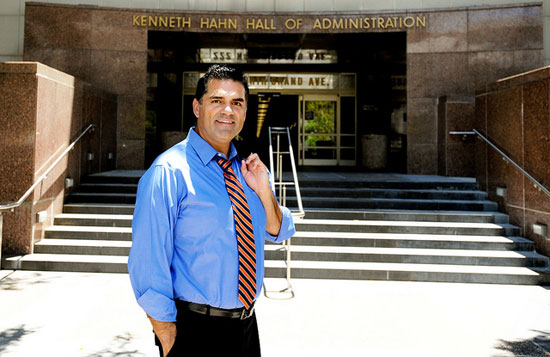
Noguez says he will begin a voluntary leave as soon as a Chief Deputy Assessor is named to run the office.
Los Angeles County Assessor John Noguez, buffeted by allegations that he gave preferential treatment to some property owners, announced today that he will take a leave of absence from his position as soon as a temporary successor can be appointed.
In a June 1 letter to the Board of Supervisors, Noguez said he is taking the voluntary leave “in the interest of restoring public confidence in the professionalism, integrity, and impartiality of the Assessor’s Office.”
“I do not take this decision lightly,” he wrote. “It is my sincere hope that the leave of absence will allow the Assessor’s Office to adhere to its mission during this important time.”
Noguez and members of his staff currently are being investigated by the D.A.’s public integrity unit. In his letter, Noguez said he and his office are cooperating with the probe.
Since the position of Chief Deputy Assessor currently is vacant, Noguez asked supervisors to designate “a highly qualified person” for the post to manage the office while Noguez is on leave. Noguez would actually make the appointment, but said in his letter that he preferred to stay out of the selection process in order to “remove any possible concerns” about his involvement.
Board of Supervisors Chairman Zev Yaroslavsky has introduced a motion directing the county’s Chief Executive Office to come up with candidates for the position. The motion, to be considered next week, calls for the board to discuss the candidates and recommend one of them for the job during open session.
In a statement, Yaroslavsky said Noguez made the right call in taking the leave of absence.
“Assessor Noguez’s decision to step aside allows for a new person to come in and restore order and integrity to an office that is currently shrouded in a cloud of uncertainty,” Yaroslavsky said. “His decision is in the best interest of the county, the Assessor’s Office, and the taxpayers.”
Posted 6/1/12




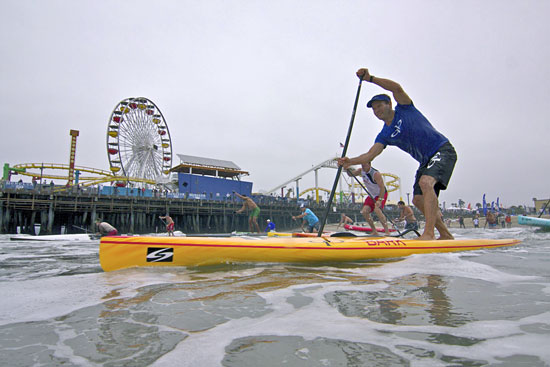

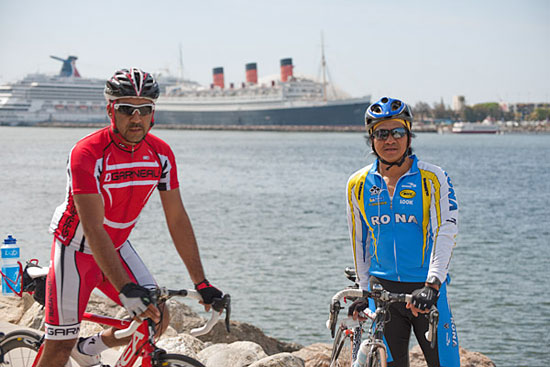





 Check for the latest closure information
Check for the latest closure information








